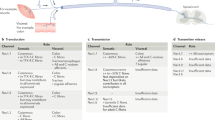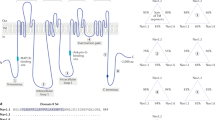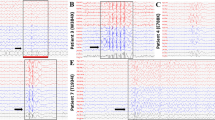Abstract
The complete inability to sense pain in an otherwise healthy individual is a very rare phenotype. In three consanguineous families from northern Pakistan, we mapped the condition as an autosomal-recessive trait to chromosome 2q24.3. This region contains the gene SCN9A, encoding the α-subunit of the voltage-gated sodium channel, Nav1.7, which is strongly expressed in nociceptive neurons. Sequence analysis of SCN9A in affected individuals revealed three distinct homozygous nonsense mutations (S459X, I767X and W897X). We show that these mutations cause loss of function of Nav1.7 by co-expression of wild-type or mutant human Nav1.7 with sodium channel β1 and β2 subunits in HEK293 cells. In cells expressing mutant Nav1.7, the currents were no greater than background. Our data suggest that SCN9A is an essential and non-redundant requirement for nociception in humans. These findings should stimulate the search for novel analgesics that selectively target this sodium channel subunit.
This is a preview of subscription content, access via your institution
Access options
Subscribe to this journal
Receive 51 print issues and online access
$199.00 per year
only $3.90 per issue
Buy this article
- Purchase on SpringerLink
- Instant access to full article PDF
Prices may be subject to local taxes which are calculated during checkout




Similar content being viewed by others
References
Dearborn, G. A case of congenital general pure analgesia. J. Nerv. Ment. Dis. 75, 612–615 (1932)
Dyck, P. J. et al. Not ‘indifference to pain’ but varieties of hereditary sensory and autonomic neuropathy. Brain 106, 373–390 (1983)
Landrieu, P., Said, G. & Allaire, C. Dominantly transmitted congenital indifference to pain. Ann. Neurol. 27, 574–578 (1990)
Nagasako, E. M., Oaklander, A. L. & Dworkin, R. H. Congenital insensitivity to pain: an update. Pain 101, 213–219 (2003)
Klein, C. J., Sinnreich, M. & Dyck, P. J. Indifference rather than insensitivity to pain. Ann. Neurol. 53, 417–418 (2003); author reply Ann. Neurol. 53, 418–419 (2003)
Klugbauer, N., Lacinova, L., Flockerzi, V. & Hofmann, F. Structure and functional expression of a new member of the tetrodotoxin-sensitive voltage-activated sodium channel family from human neuroendocrine cells. EMBO J. 14, 1084–1090 (1995)
Toledo-Aral, J. J. et al. Identification of PN1, a predominant voltage-dependent sodium channel expressed principally in peripheral neurons. Proc. Natl Acad. Sci. USA 94, 1527–1532 (1997)
Sangameswaran, L. et al. A novel tetrodotoxin-sensitive, voltage-gated sodium channel expressed in rat and human dorsal root ganglia. J. Biol. Chem. 272, 14805–14809 (1997)
Rush, A. M. et al. A single sodium channel mutation produces hyper- or hypoexcitability in different types of neurons. Proc. Natl Acad. Sci. USA 103, 8245–8250 (2006)
Amir, R. et al. The role of sodium channels in chronic inflammatory and neuropathic pain. J. Pain 7, S1–29 (2006)
Cummins, T. R., Howe, J. R. & Waxman, S. G. Slow closed-state inactivation: a novel mechanism underlying ramp currents in cells expressing the hNE/PN1 sodium channel. J. Neurosci. 18, 9607–9619 (1998)
Amrani, N., Sachs, M. S. & Jacobson, A. Early nonsense: mRNA decay solves a translational problem. Nature Rev. Mol. Cell Biol. 7, 415–425 (2006)
Black, J. A. et al. Spinal sensory neurons express multiple sodium channel α-subunit mRNAs. Brain Res. Mol. Brain Res. 43, 117–131 (1996)
Catterall, W. A. From ionic currents to molecular mechanisms: the structure and function of voltage-gated sodium channels. Neuron 26, 13–25 (2000)
Isom, L. L. Sodium channel β subunits: anything but auxiliary. Neuroscientist 7, 42–54 (2001)
Cummins, T. R., Dib-Hajj, S. D. & Waxman, S. G. Electrophysiological properties of mutant Nav1.7 sodium channels in a painful inherited neuropathy. J. Neurosci. 24, 8232–8236 (2004)
Catterall, W. A., Goldin, A. L. & Waxman, S. G. International Union of Pharmacology. XLVII. Nomenclature and structure-function relationships of voltage-gated sodium channels. Pharmacol. Rev. 57, 397–409 (2005)
Herzog, R. I., Cummins, T. R., Ghassemi, F., Dib-Hajj, S. D. & Waxman, S. G. Distinct repriming and closed-state inactivation kinetics of Nav1.6 and Nav1.7 sodium channels in mouse spinal sensory neurons. J. Physiol. (Lond.) 551, 741–750 (2003)
Renganathan, M., Cummins, T. R. & Waxman, S. G. Contribution of Na(v)1.8 sodium channels to action potential electrogenesis in DRG neurons. J. Neurophysiol. 86, 629–640 (2001)
Blair, N. T. & Bean, B. P. Roles of tetrodotoxin (TTX)-sensitive Na+ current, TTX-resistant Na+ current, and Ca2+ current in the action potentials of nociceptive sensory neurons. J. Neurosci. 22, 10277–10290 (2002)
Raymond, C. K. et al. Expression of alternatively spliced sodium channel α-subunit genes. Unique splicing patterns are observed in dorsal root ganglia. J. Biol. Chem. 279, 46234–46241 (2004)
Yang, Y. et al. Mutations in SCN9A, encoding a sodium channel α subunit, in patients with primary erythermalgia. J. Med. Genet. 41, 171–174 (2004)
Dib-Hajj, S. D. et al. Gain-of-function mutation in Nav1.7 in familial erythromelalgia induces bursting of sensory neurons. Brain 128, 1847–1854 (2005)
Han, C. et al. Sporadic onset of erythermalgia: a gain-of-function mutation in Nav1.7. Ann. Neurol. 59, 553–558 (2006)
Nassar, M. A. et al. Nociceptor-specific gene deletion reveals a major role for Nav1.7 (PN1) in acute and inflammatory pain. Proc. Natl Acad. Sci. USA 101, 12706–12711 (2004)
Nassar, M. A., Levato, A., Stirling, L. C. & Wood, J. N. Neuropathic pain develops normally in mice lacking both Nav1.7 and Nav1.8. Mol. Pain 1, 24 (2005)
Akopian, A. N., Abson, N. C. & Wood, J. N. Molecular genetic approaches to nociceptor development and function. Trends Neurosci. 19, 240–246 (1996)
Scholz, J. & Woolf, C. J. Can we conquer pain?. Nature Neurosci. 5, (Suppl)1062–1067 (2002)
Acknowledgements
We thank the families who participated in this study, A. Boylston for critical advice, and Pfizer, the Wellcome Trust and St John’s College, Cambridge for funding. Author Contributions This study was designed by J.J.C., F.R., E.R., R.W., D.P.M., F.M.G. and C.G.W.; patient identification and phenotype assessment was performed by G.K., H.J., J.M., Y.R., L.A.-G., H.H., E.M.V., S.G. and C.G.W.; DNA extraction, linkage analysis, bioinformatics and sequencing was performed by J.J.C., A.K.N., E.R., K.S. and C.G.W.; cloning was performed by J.J.C.; electrophysiology was performed by F.R. and F.M.G.; and the paper was written by J.J.C., F.R., G.T., J.N.W., F.M.G. and C.G.W.
Author information
Authors and Affiliations
Corresponding author
Ethics declarations
Competing interests
The sequence for full-length human SCN9A cloned from fetal brain mRNA is deposited in GenBank under accession number DQ857292. Reprints and permissions information is available at www.nature.com/reprints. The authors declare no competing financial interests.
Supplementary information
Supplementary Information
This file contains Supplementary Methods discussing cloning methodology used to generate the constructs for this study, Supplementary Figures 1- 2 and Supplementary Tables 1-2. Supplementary Figure 1 shows kinetic properties of whole cell wild-type NaV1.7+NaVβ1+NaVβ2 currents in HEK293 cells. Supplementary Figure 2 shows alignment of the amino acid sequences of the corresponding common splice variants for the human (NP_002968) and mouse Nav1.7 (XP_904764) proteins using the LALIGN program (: = identical amino acid; . = similar amino acid). Supplementary Table 1 shows markers used to search for common haplotype blocks between the three families.Supplementary Table 2 shows primers used to amplify and sequence the coding exons and splice sites of SCN9A (PDF 5083 kb)
Rights and permissions
About this article
Cite this article
Cox, J., Reimann, F., Nicholas, A. et al. An SCN9A channelopathy causes congenital inability to experience pain. Nature 444, 894–898 (2006). https://doi.org/10.1038/nature05413
Received:
Accepted:
Issue Date:
DOI: https://doi.org/10.1038/nature05413
This article is cited by
-
Transient binocular vision loss and pain insensitivity in Klippel–Feil syndrome: a case report
Journal of Medical Case Reports (2024)
-
Functionally-selective inhibition of threshold sodium currents and excitability in dorsal root ganglion neurons by cannabinol
Communications Biology (2024)
-
Nav1.7 as a chondrocyte regulator and therapeutic target for osteoarthritis
Nature (2024)
-
Gene therapy for chronic pain: emerging opportunities in target-rich peripheral nociceptors
Nature Reviews Neuroscience (2023)
-
Maximizing treatment efficacy through patient stratification in neuropathic pain trials
Nature Reviews Neurology (2023)



